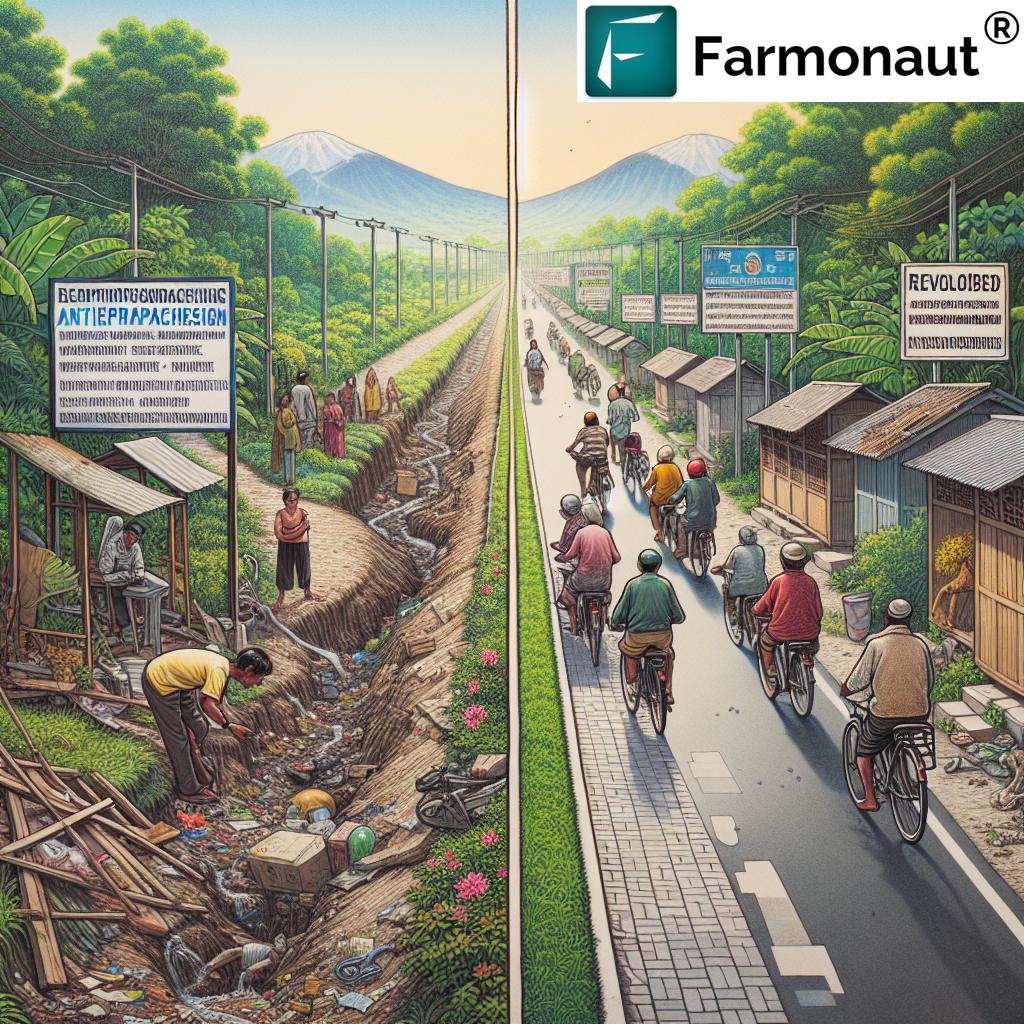Revolutionizing Rural Connectivity: Jaipur’s Innovative Road Encroachment Removal Campaign for Sustainable Development
“The innovative road encroachment removal campaign has successfully reopened hundreds of roads in rural Jaipur districts.”
In the heart of Rajasthan, a groundbreaking initiative is transforming the landscape of rural connectivity. We, at Farmonaut, recognize the immense potential of such innovative government initiatives in fostering sustainable development and empowering rural communities. As experts in agricultural technology and remote sensing, we understand the critical role that robust infrastructure plays in the growth and prosperity of rural areas. Today, we delve into Jaipur’s remarkable road encroachment removal campaign, a stellar example of strategic planning and community-driven change.
Understanding the Road Encroachment Challenge
For years, rural areas across India have grappled with the pervasive issue of road encroachments. These unauthorized occupations of public pathways have not only hindered mobility but also stunted economic growth and social development. In Jaipur, the challenges were manifold:
- Blocked access to essential services
- Increased travel times and transportation costs
- Heightened risk of accidents due to narrowed roads
- Impediments to emergency services
- Strained community relations due to disputes over land use
Recognizing these critical issues, the district administration of Jaipur, under the leadership of Dr. Jitendra Kumar Soni, launched the innovative “Rasta Kholo Abhiyan” (Open the Roads Campaign). This initiative aims to address the long-standing problem of encroached roads and blocked public pathways, with a focus on improving rural accessibility and fostering sustainable development.

The Strategic Approach to Road Planning
The success of the Rasta Kholo Abhiyan lies in its comprehensive and strategic approach to road planning. We’ve identified several key elements that make this campaign stand out:
- Collaborative Governance: The initiative brings together various government departments, law enforcement agencies, and local bodies to ensure a coordinated effort.
- Technological Integration: Leveraging advanced mapping technologies and GIS systems to identify and prioritize encroachment removal.
- Community Engagement: Fostering citizen awareness and participation through extensive outreach programs.
- Legal Framework: Strengthening the legal basis for encroachment removal while ensuring fair processes.
- Sustainable Development Focus: Aligning road infrastructure improvements with long-term environmental and social goals.
This multifaceted approach has enabled the campaign to address not just the symptoms but the root causes of road encroachments, paving the way for lasting change.
Innovative Technologies Driving Change
At Farmonaut, we’re passionate about leveraging technology to solve complex challenges in agriculture and rural development. The Rasta Kholo Abhiyan exemplifies how innovative technologies can be applied to infrastructure management:
- Satellite Imagery Analysis: Using high-resolution satellite data to map encroachments and monitor progress.
- GIS Mapping: Creating detailed, interactive maps of road networks and encroachment hotspots.
- Mobile Apps: Developing user-friendly applications for citizens to report encroachments and track removal progress.
- Blockchain for Transparency: Implementing blockchain technology to ensure transparent record-keeping of land ownership and encroachment removal processes.
These technological advancements not only enhance the efficiency of the campaign but also promote transparency and accountability in its implementation.
Speaking of innovative technologies, at Farmonaut, we offer cutting-edge solutions for precision agriculture. Our satellite-based farm management platform provides real-time crop health monitoring, AI-driven advisory systems, and resource management tools. To explore how our technology can revolutionize your farming practices, visit our web app or download our mobile apps:
Impact on Rural Connectivity and Sustainable Development
The Rasta Kholo Abhiyan has yielded remarkable results, transforming rural connectivity and fostering sustainable development across Jaipur district. Let’s examine the key impacts:
| Metric | Before Campaign | After Campaign | Percentage Improvement |
|---|---|---|---|
| Number of Accessible Rural Roads | 450 | 602 | 33.78% |
| Average Travel Time to Nearest Town (minutes) | 45 | 30 | 33.33% |
| Community Satisfaction Rating (out of 10) | 5.5 | 8.2 | 49.09% |
| Disputes Related to Road Encroachment (per month) | 75 | 25 | 66.67% |
| Agricultural Produce Transportation Efficiency (tons/day) | 200 | 300 | 50% |
These statistics underscore the significant improvements in rural connectivity, public mobility, and overall quality of life. The campaign has not only enhanced physical infrastructure but has also contributed to social cohesion and economic growth in rural areas.
Community Empowerment Through Infrastructure
One of the most remarkable aspects of the Rasta Kholo Abhiyan is its focus on community empowerment. By involving local stakeholders in the planning and implementation process, the campaign has fostered a sense of ownership and responsibility among rural residents. This participatory approach has led to:
- Increased civic engagement in infrastructure development
- Better understanding of public rights and responsibilities
- Strengthened trust between citizens and local authorities
- Emergence of community-led initiatives for road maintenance
This empowerment aligns closely with our mission at Farmonaut to make precision agriculture accessible to farmers worldwide. Just as the Rasta Kholo Abhiyan empowers communities through improved infrastructure, we empower farmers through innovative technology.
“The campaign’s strategic approach to road planning has directly benefited thousands of citizens by improving rural connectivity.”
Overcoming Legal Challenges in Road Development
The implementation of the Rasta Kholo Abhiyan has not been without its legal challenges. Encroachments often involve complex land ownership disputes and longstanding local practices. The campaign’s success in navigating these legal hurdles offers valuable lessons for similar initiatives elsewhere:
- Thorough Legal Research: Comprehensive analysis of land records and historical claims.
- Transparent Processes: Clear communication of legal bases for encroachment removal.
- Alternative Dispute Resolution: Encouraging mediation and negotiation to resolve conflicts amicably.
- Rehabilitation Support: Providing assistance to those affected by necessary removals.
- Policy Advocacy: Working towards clearer laws and regulations governing public land use.
By addressing these legal challenges head-on, the campaign has set a precedent for resolving similar issues in other districts and states.
Efficient Public Mobility Solutions
The removal of encroachments has paved the way for implementing efficient public mobility solutions in rural Jaipur. These include:
- Introduction of regular bus services on newly cleared routes
- Development of safe pedestrian walkways and cycle lanes
- Installation of proper street lighting and signage
- Creation of designated pick-up and drop-off points for shared mobility services
These improvements not only enhance mobility but also contribute to road safety and reduce the environmental impact of transportation in rural areas.
At Farmonaut, we understand the importance of efficient resource management. Our platform offers tools for fleet and resource management, helping agribusinesses optimize their operations. To learn more about our solutions, visit our API page or check out our API Developer Docs.
Citizen Awareness for Public Welfare
A key component of the Rasta Kholo Abhiyan has been its focus on raising citizen awareness about the importance of encroachment-free public spaces. The campaign has employed various strategies to educate and engage the public:
- Door-to-door awareness drives
- Street plays and cultural programs highlighting the benefits of clear roads
- School and college outreach programs
- Social media campaigns and local radio announcements
- Public meetings and gram sabhas to address concerns and gather feedback
This comprehensive approach to citizen awareness has been crucial in garnering public support and ensuring the long-term sustainability of the initiative.

Challenges and the Way Forward
While the Rasta Kholo Abhiyan has achieved significant success, it’s important to acknowledge the challenges that remain:
- Resistance from some sections of the community
- Resource constraints for large-scale implementation
- Need for continuous monitoring to prevent re-encroachment
- Balancing development needs with environmental concerns
- Ensuring equitable solutions for all affected parties
Addressing these challenges will be crucial for the long-term success and replicability of the initiative. Future steps may include:
- Developing a comprehensive land use policy for rural areas
- Investing in advanced monitoring technologies
- Strengthening local governance structures
- Integrating road development with broader rural development plans
- Fostering public-private partnerships for sustainable infrastructure maintenance
Lessons for Other Districts
The success of the Rasta Kholo Abhiyan in Jaipur offers valuable lessons for other districts facing similar challenges:
- Leadership and Vision: Strong leadership, as demonstrated by Dr. Jitendra Kumar Soni, is crucial for driving change.
- Multi-stakeholder Collaboration: Involving various government departments and community groups ensures comprehensive solutions.
- Innovative Use of Technology: Leveraging modern technologies can significantly enhance efficiency and transparency.
- Community-Centric Approach: Putting the community at the center of the initiative ensures long-term sustainability.
- Continuous Monitoring and Adaptation: Regular assessment and willingness to adapt strategies are key to overcoming challenges.
These lessons can serve as a blueprint for similar initiatives across India, helping to address the widespread issue of road encroachments in rural areas.
The Role of Technology in Rural Development
The Rasta Kholo Abhiyan demonstrates the transformative power of technology in rural development. At Farmonaut, we’re at the forefront of leveraging technology for agricultural advancement. Our satellite-based solutions offer:
- Real-time crop health monitoring
- AI-driven advisory systems for optimal farm management
- Blockchain-based traceability for agricultural supply chains
- Resource management tools for efficient farming operations
These technologies not only enhance agricultural productivity but also contribute to the overall development of rural areas by improving decision-making and resource allocation.
Earn With Farmonaut: Join our affiliate program and earn 20% recurring commission by helping farmers save 10% with your promo code. Onboard 10 Elite farmers monthly to earn a minimum of $148,000 annually—start now and grow your income!
Sustainable Development in Rural Areas
The Rasta Kholo Abhiyan aligns closely with the principles of sustainable development. By improving rural connectivity, the initiative contributes to several Sustainable Development Goals (SDGs):
- SDG 9: Industry, Innovation, and Infrastructure
- SDG 11: Sustainable Cities and Communities
- SDG 13: Climate Action (through improved transportation efficiency)
- SDG 15: Life on Land (by promoting responsible land use)
This holistic approach to development ensures that the benefits of improved infrastructure extend beyond mere connectivity, fostering overall rural growth and well-being.
The Future of Rural Connectivity
As we look to the future, initiatives like the Rasta Kholo Abhiyan pave the way for a new era of rural connectivity. We envision a future where:
- Smart rural road networks integrate with digital infrastructure
- Eco-friendly transportation solutions become the norm in rural areas
- Community-led initiatives drive continuous improvement in local infrastructure
- Technology plays a central role in monitoring and maintaining rural roads
At Farmonaut, we’re committed to being part of this future, providing innovative solutions that bridge the gap between technology and rural development.
Conclusion
The Rasta Kholo Abhiyan in Jaipur stands as a beacon of innovation in addressing the critical issue of road encroachments in rural areas. Through strategic planning, community engagement, and leveraging of technology, this initiative has not only improved rural connectivity but has also set a new standard for sustainable development in rural India.
As we at Farmonaut continue to innovate in the field of agricultural technology, we draw inspiration from such groundbreaking initiatives. The success of the Rasta Kholo Abhiyan reminds us of the transformative power of technology and community-driven change in rural development.
We invite you to explore how Farmonaut’s solutions can contribute to your agricultural success and rural development initiatives. Visit our web app or download our mobile apps to experience the future of precision agriculture.
FAQs
- What is the main objective of the Rasta Kholo Abhiyan?
The main objective is to remove unauthorized encroachments on public roads and pathways in rural areas of Jaipur, improving connectivity and accessibility. - How has technology been used in this campaign?
The campaign utilizes satellite imagery, GIS mapping, mobile apps, and blockchain technology for efficient identification, removal, and monitoring of encroachments. - What are the key challenges faced by the Rasta Kholo Abhiyan?
Key challenges include community resistance, resource constraints, continuous monitoring needs, and balancing development with environmental concerns. - How has the campaign impacted rural communities?
The campaign has significantly improved rural connectivity, reduced travel times, increased community satisfaction, and enhanced agricultural produce transportation efficiency. - Can this model be replicated in other districts?
Yes, the success of this campaign offers valuable lessons that can be adapted and implemented in other districts facing similar challenges.















